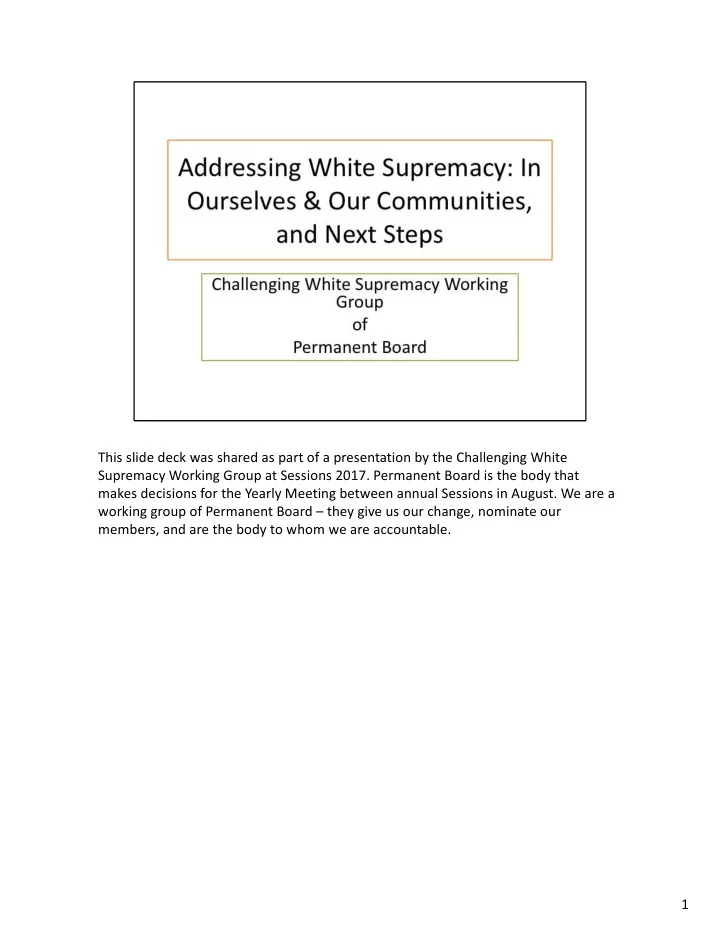

This slide deck was shared as part of a presentation by the Challenging White Supremacy Working Group at Sessions 2017. Permanent Board is the body that makes decisions for the Yearly Meeting between annual Sessions in August. We are a working group of Permanent Board – they give us our change, nominate our members, and are the body to whom we are accountable. 1
2
How we understand the relationship between white supremacy, structural racism, and white privilege – words we are using more frequently and can have many different connotations for different people. What do you think of when you hear these words? How do you understand their interconnectedness? 3
We can move through different “zones” when talking about a topic. Information or situations that are not new and with which we are familiar often keeps us in our comfort zone. Information or situations that are new, complex, challenging, or allows us to see things in a new light pushes us into our stretch or learning zone. Information or situations that we find overwhelming or threatening or fundamentally change how we see something dear to us can push us into a panic zone. We can process, explore, engage, and develop in our comfort and learning zones. We often revert to a fight or flight stance or become very protective and deflective in our panic zones. The goal, as we move forward together to bring about racial justice, is be aware when we are moving from one zone to the other and ask for the support we need in each space. 4
Personal sharing: Lisa Graustein (Beacon Hill Friends Meeting, Boston) shared that when she first started her teaching career out of college and was beginning to go to a lot of diversity workshops, her comfort/learning/panic zone looked like the one on the left – the stretch or learning zone was very small and the panic zone was really large. However, through the process of listening to other people, learning more and reflecting on her own experiences, Lisa now inhabits a space that looks more like the diagram on the right. The comfort and stretch zones have expanded significantly. This has brought not just more facility with being an agent for racial justice and comfort in widely diverse groups, but a much richer social and spiritual life that feels more grounded and connected. Sitting in the discomfort and facing the realities that once felt overwhelming has been transformative in very positive ways. 5
Partner up with another Friend or two. What comes up for you when we talk about naming and challenging white supremacy in ourselves, our meetings, and our communities. What are things that help you stay in a stretch or learning zone. 6
This graphic is a list of some of the ways that social change happens. It is also a way for us to think about how we, as Friends, can do more to challenge white supremacy and work for racial justice and healing. 7
We asked meetings and worship groups to share with us what they are doing to challenge white supremacy. These next few slides summarize the responses we received. We did not hear back from all meetings and worship groups, so we know these slides do not fully represent the full scope of the work being done throughout NEYM, 8
9
Often, when the term white supremacy is used, people think of hate groups. These groups are at one end of the spectrum of how white supremacy manifests. Much of white supremacy is deeply intertwined with U.S. society in more subtle ways. Developing a practice of paying attention to the different ways in which white supremacy moves and operates among us is an important step in being able to more directly and effectively challenge white supremacy and work for racial justice. 10
These next few slides name a few of the ways that white supremacy shows up in our society today. The first column identifies some the key historical moments or institutions that perpetuate the dynamic of white supremacy. The column in the right lists some ways in which this dynamic shows up today, and the bottom lines name some of the mindsets or ways of thinking that come from and continue the given dynamic of white supremacy. There have always been People of Color, and a few white people, who have resisted white supremacy in all its forms. 11
12
13
14
15
16
17
Recommend
More recommend